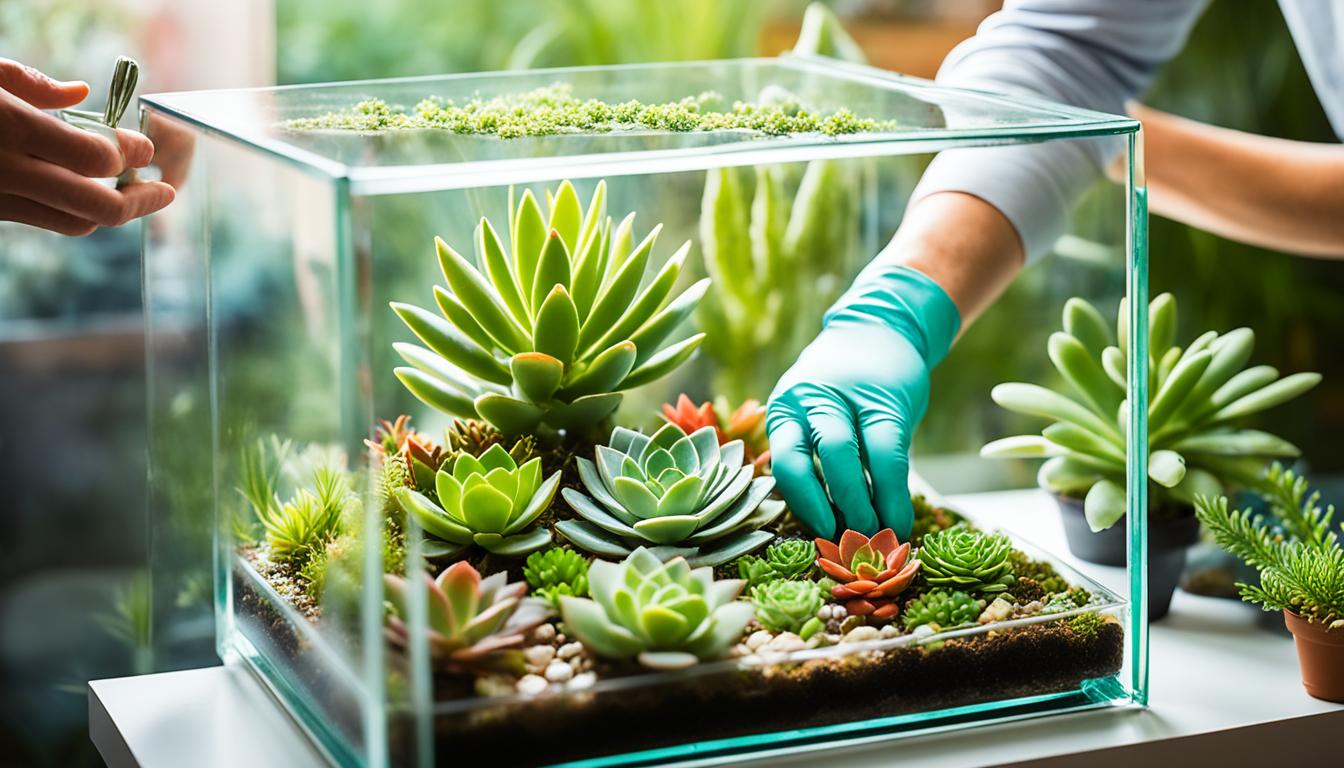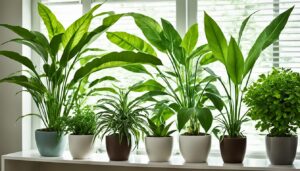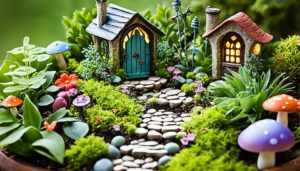Ever thought about bringing nature’s beauty indoors without the hard work of gardening? A succulent terrarium could be just what you need. These mini worlds are not only beautiful but also simple to make and care for.
This guide will show you how to make your own DIY succulent terrarium. It’s perfect for both plant experts and beginners wanting to brighten up their space. You’ll learn everything you need to create a stunning living work of art.
Prepare to turn a simple glass container into a vibrant mini garden. It will amaze your guests and fill your life with joy. Let’s explore the world of succulents and make your own little paradise!
Key Takeaways
- Succulent terrariums are low-maintenance, living art pieces
- Proper container selection is crucial for terrarium success
- Layering materials create an ideal environment for succulents
- Choosing the right succulents ensures a thriving mini-ecosystem
- Decorative elements add personality to your terrarium
- Regular care keeps your succulent terrarium healthy and beautiful
Introduction to Succulent Terrariums
Succulent terrariums are small gardens that bring nature inside. They are perfect for those who love plants but don’t have a lot of time. These gardens are easy to take care of and look beautiful.
What is a succulent terrarium?
A succulent terrarium is a tiny garden filled with plants that keep water in their leaves and stems. They are put in glass containers, making them look unique and beautiful. You can make terrariums simple or complex, making them great for any room.
Benefits of creating your own terrarium
Creating a terrarium has many benefits:
- Low maintenance: Succulents need little care, perfect for busy people
- Improved air quality: Plants clean the air in your home
- Stress relief: Gardening, even in a small way, can help reduce stress
- Customizable decor: You can make your terrarium fit your style and home
Overview of the process
Starting a succulent garden in a jar is easy. First, pick a container and gather materials like gravel, activated charcoal, and soil. Then, arrange your succulents in the container. Finally, add decorations to finish your mini garden. With a little creativity and care, you’ll have a lovely terrarium to enjoy.
Gathering Materials for Your Terrarium
Starting a beautiful succulent terrarium means getting the right supplies. Your succulent terrarium supplies list should have everything your mini garden needs. Let’s look at the key materials you’ll need for this fun project.
First, pick a glass container that fits your style and space. Then, choose succulents that look good together. You’ll need cactus or succulent potting mix for the plants to grow well.
Add decorative rocks or pebbles for looks and drainage. These also help keep the soil moist.
Remember to include sphagnum moss and activated charcoal too. They’re key for keeping moisture in and smells down. Tools like tweezers and a mini shovel will help with planting.
| Essential Supplies | Optional Accessories |
|---|---|
| Glass container | Miniature figures |
| Succulents | Decorative sand |
| Cactus potting mix | Colored stones |
| Pebbles | Fairy lights |
| Sphagnum moss | Tiny garden tools |
| Activated charcoal | Spray bottle |
For a green touch, think about using recycled potting soil. With these supplies ready, you’re all set to start your terrarium project!
Choosing the Perfect Container
Finding the right container is key to a successful succulent terrarium. Glass terrarium containers come in many shapes and sizes. This gives you endless options for your succulent planter ideas.
Types of Containers
Glass bowls, jars, and vases with open tops or sides are great for terrariums. Choose containers with wide openings for easy planting and upkeep. Some top picks include:
- Fish bowls
- Mason jars
- Glass cylinders
- Geometric terrariums
Size and Shape Considerations
Think about the size and shape that fits your space and style. Aim for containers at least 2-3 inches deep for root growth. Bigger containers let you get creative with your succulent planter ideas.
Drainage Importance
Good drainage is crucial for succulent health. Many glass terrarium containers don’t have drainage holes. But, you can add a layer of rocks or pebbles for drainage. This stops water from gathering at the bottom and prevents root rot.
Choosing the right container sets the stage for a beautiful, thriving succulent terrarium. It will brighten your space for years.
Selecting Succulents for Your Terrarium
Choosing the right succulents for your terrarium is key to a thriving mini garden. Look for plants with different shapes, sizes, and textures. This adds visual interest to your terrarium.
Some top choices for terrariums include:
- Echeveria
- Sedum
- Haworthia
- Crassula
- Kalanchoe
These plants are perfect for terrariums because they fit well in small spaces and come in many colors and shapes. Make sure to pick succulents that are small enough for your container. This lets them grow without crowding.
Don’t use cacti in your terrarium because they need different care and don’t do well in closed spaces. Instead, choose low-maintenance succulents that like similar conditions.
“A well-designed succulent terrarium is like a miniature landscape, with each plant playing a unique role in the overall composition.”
For beginners, pre-arranged succulent sets are a good place to start. These sets have plants that work well together, giving your terrarium a cohesive look. As you get more experience, you can try mixing different succulents to make your own unique terrarium.
Think about the light your succulents need. Most like bright, indirect sunlight, but some can handle less light. By picking the right plants, you’ll have a beautiful, lasting succulent terrarium that adds nature to your space.
Preparing the Terrarium Base
Creating a solid foundation for your succulent terrarium is key to its health. Let’s look at the key terrarium layering techniques for success.
Adding a Layer of Gravel or Pebbles
Begin with a 1-2 inch layer of small gravel or pebbles at the container’s bottom. This layer prevents water from pooling, which can cause root rot.
Incorporating Activated Charcoal
Next, add a thin layer of activated charcoal on top of the gravel. It purifies water and keeps the terrarium fresh by absorbing odors and chemicals.
Creating a Moss Barrier
Then, put a layer of sphagnum moss over the charcoal. This barrier keeps the drainage materials separate from the succulent soil mix. It prevents soil from clogging the drainage layer.
| Layer | Purpose | Thickness |
|---|---|---|
| Gravel/Pebbles | Drainage | 1-2 inches |
| Activated Charcoal | Filtration | 1/4 inch |
| Sphagnum Moss | Barrier | 1/2 inch |
| Succulent Soil Mix | Planting Medium | 2-3 inches |
With these layers set, you’re ready to add your succulent soil mix. Use a mix made for succulents or create your own with potting soil, coarse sand, and perlite. This mix ensures good drainage and aeration for your succulents.
Succulent Terrarium Tutorial: Step-by-Step Guide
Are you ready to make your own succulent terrarium? This step-by-step guide will help you create a miniature garden. Let’s start with the planting and add some creativity to your terrarium.
Adding the Potting Soil
Begin by filling your container with succulent soil mix. Put it over the moss barrier, making a layer of 2-3 inches. This gives your plants’ roots enough room to grow well.
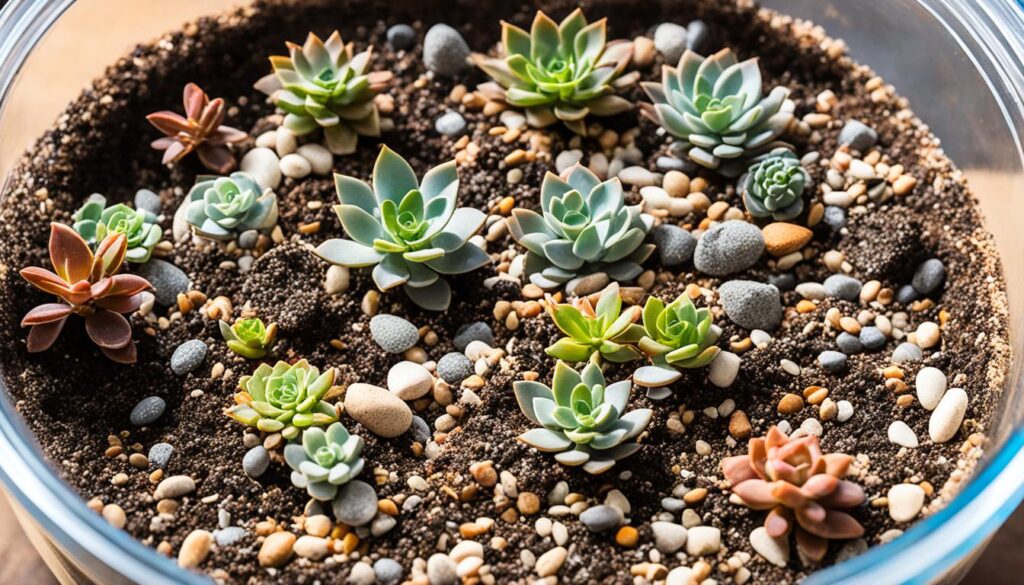
Arranging and Planting Succulents
Now, it’s time to have fun! Take your succulents out of their pots and gently loosen their roots. Put them in the soil, leaving an inch between each plant. Be creative with your arrangement. Mix different heights, colors, and textures for a great look.
- Remove excess soil from roots
- Create small holes in the soil for each plant
- Firmly press soil around the base of each succulent
Adding Decorative Elements
Add decorative touches to your terrarium. Place small rocks, pebbles, or miniature figurines among your plants. These add personality and finish your terrarium’s look.
| Decorative Item | Purpose | Placement |
|---|---|---|
| Colored sand | Visual contrast | Between plants |
| Mini figurines | Whimsical touch | Front corners |
| Driftwood | Natural accent | Center or side |
Finish by misting the soil with water lightly. Your terrarium is now complete, a beautiful, living piece of art!
Caring for Your Succulent Terrarium
Proper care is crucial for a thriving succulent terrarium. With the right steps, your terrarium will be a lasting, beautiful part of your home.
Put your terrarium in a spot with bright, indirect sunlight. This ensures your succulents grow well without getting sunburned. Make sure to turn the container every few weeks for even light.
Watering your terrarium succulents needs to be done carefully. Use a mister or turkey baster for precise watering. Only water when the soil is dry, usually every 7-10 days. Be careful not to overwater, as it’s easy to do.
- Remove dead or dying leaves promptly
- Fertilize lightly during spring and summer
- Use a diluted, balanced fertilizer
Watch for pests or signs of disease. If you see any, deal with them fast to stop them from spreading. With these easy care tips, your succulent terrarium will thrive. It will add a peaceful touch to your space.
Troubleshooting Common Issues
Every succulent terrarium owner faces challenges. Let’s look at some common problems and how to fix them. This will help keep your mini garden healthy.
Dealing with Overwatering
Overwatering is a big issue in succulent terrariums. Look for yellow leaves and mushy stems. To fix it, take out the plants and let them dry out.
Then, replant them in fresh, dry soil. Change your watering ways. Only water when the soil is dry.
Addressing Pest Problems
Pests can harm your terrarium plants. If you see tiny bugs or webs, act fast. Move the affected plants apart and use neem oil or insecticidal soap to treat them.
Checking your plants often helps you spot pests early.
Managing Light Requirements
Not enough light can make succulents stretch or lose color. If your plants are getting too long or losing their color, they need more light. You can slowly add more light or use grow lights.
| Issue | Symptoms | Solution |
|---|---|---|
| Overwatering | Yellow leaves, mushy stems | Dry out plants, replant in fresh soil |
| Pest Infestation | Visible insects, webs | Isolate plants, treat with neem oil |
| Light Deficiency | Leggy growth, color loss | Increase light exposure gradually |
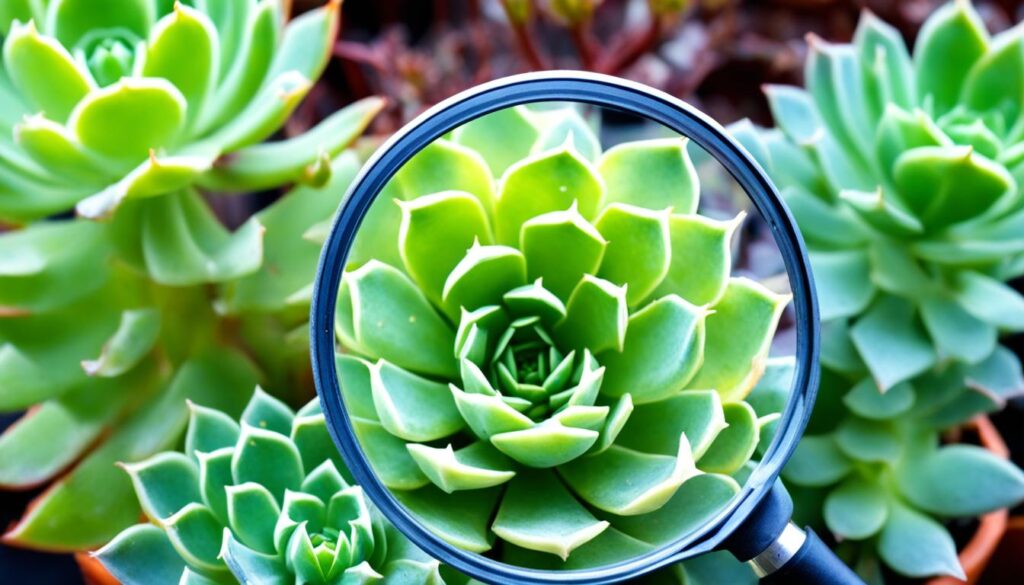
Fixing these common issues quickly will keep your succulent terrarium healthy and lovely for many years.
Conclusion
Making a succulent terrarium is a fun and rewarding project. It brings a touch of nature into your home. You can express your creativity with endless ideas for these miniature gardens.
Follow the steps in this guide to create a beautiful, low-maintenance display. This will thrive for years.
The key to a successful terrarium is proper care and attention to detail. Choosing the right container and succulents is crucial for their health and longevity. As you gain experience, you’ll find new tips to improve your designs.
Don’t be afraid to try different plant combinations, containers, and decorations. Each terrarium you make will be unique, showing off your personal style. With practice, you’ll get better at arranging succulents and creating beautiful miniature landscapes.
So, grab your supplies, let your imagination run wild, and start making your own succulent terrarium today. You’ll soon have a beautiful, living piece of art that adds joy and tranquility to your home.
FAQ
What is a succulent terrarium?
A succulent terrarium is a small indoor garden in a glass container. It has soil, drought-resistant plants, and decorations. This setup is easy to take care of.
What materials do I need to make a succulent terrarium?
You’ll need a glass container, succulents, and special potting mix. Also, get decorative rocks, sphagnum moss, activated charcoal, and gardening tools. You can also add mini figures or theme-related items.
What types of containers are suitable for terrariums?
Good containers are glass bowls, jars, or vases with open tops. They should be at least 2-3 inches deep and have wide openings for easy access and drainage.
How do I prepare the terrarium base?
Begin with a layer of gravel or pebbles for drainage. Then, add a thin layer of activated charcoal. Use sphagnum moss as a barrier to keep the soil and drainage layers separate.
How do I care for my succulent terrarium?
Keep your terrarium in bright, indirect sunlight. Water it only when the soil is dry. Use a mister or turkey baster for watering. Turn the container regularly to ensure all plants get enough light.
How do I deal with overwatering in my terrarium?
If you overwater, take out the plants and let them dry. Then, replant them in fresh, dry soil. Make sure the soil drains well and only water when it’s completely dry.
What should I do if my succulents are losing color or becoming leggy?
If your plants are losing color or getting leggy, they need more light. Slowly increase the light they get or use grow lights.
Source Links
- https://www.thespruce.com/diy-succulent-terrarium-7566763 – How to Make a DIY Succulent Terrarium Your Plants Will Love
- https://momadvice.com/post/how-to-make-succulent-terrarium – How to Make a Succulent Terrarium
- https://www.threebearsemporium.com/blogs/blog/a-beginners-guide-to-crafting-a-stunning-succulent-terrarium-step-by-step-tutorial – How to create a succulent terrarium | A step by step guide for beginners


